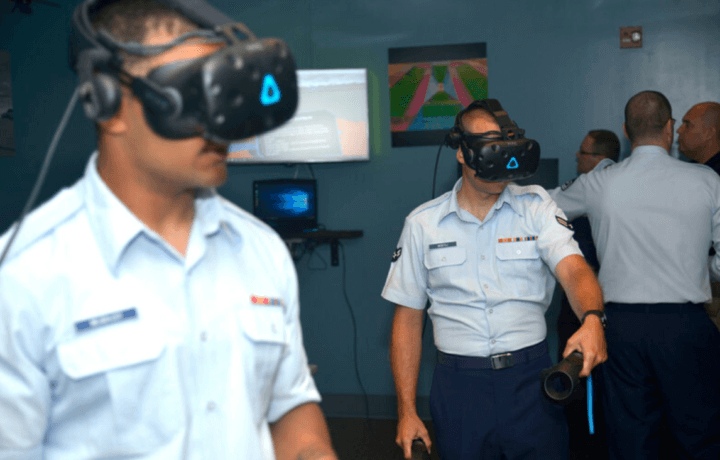When the United States Air Force’s B-52 Stratofortress bomber entered service in the 1950s, 3D movies were the “next big thing.” Now, the Air Force is testing a virtual reality (VR) system to help B-52 student-pilots prepare for combat in the Cold War era bombers. The Virtual Reality Procedures Trainer (VRPT) could even change the way that the entire bomber community approaches training. It was demonstrated earlier this month at StrikeWerz, the Air Force’s new national innovation hub in Bossier City, LA.
Team Effort to Produce Virtual REality Training
The technology is the brainchild of Maj. Mark Budgeon, currently assigned to Air Force Global Strike Command, Maj. Brandon Wolf, 307th Operations Support Squadron, and Maj. Justin Stephenson, 11th Bomb Squadron chief pilot and chief of innovations. The three Airmen partnered with King Crow Studios, a VR training company that is based in Baton Rouge, and VRPT was developed as part of a larger learning management system that can utilize VR with an embedded instructor to teach and grade B-52 student pilots.
In the recent demonstration, members of the 307th Bomb Wing, 2nd Bomb Wing, and Air Force Global Strike Command were able to watch as a demonstrator from King Grow Studios wore special VR goggles, which enabled access to a 360-degree, virtual replica of the jet bomber’s cockpit. Through the training tool, the demonstrator was able to practice going through the entire ground procedures checklist just as a student pilot would prior to take-off.
The VR system has the potential to enhance the training experience and better prepare the student pilots from everyday, routine operations to situations they hope they will never encounter.
“Our adversaries are getting much better, much faster,” explained Budgeon via USAF statement. “This system has the potential to revolutionize the entire training process and make our student graduates better.”
Virtual Reality is Becoming the New Reality
Research from Market Study Report, LLC reported that the global Military Virtual Training market would grow from $9.93 billion in 2018 to $10.8 billion by the end of 2025. As ClearanceJobs.com previously reported, simulated training isn’t entirely new and flight simulators actually date back to 1929 – but it is only in recent years that VR has come into its own.
The Air Force has also been utilizing VR along with augmented reality (AR) – virtually overlapped with the physical world – as a way to enhance training, including preparing Airmen for combat missions.
Last year, another United States Air Force Tech incubator, AFWERX, awarded a $1.5 million development grant to Santa Monica, CA -based Red 6 to develop a combat training system that uses AR to train pilots in close range air-to-air combat, ground attacks and refueling missions – all of which can be complex, expensive, and dangerous to tackle in the real world during training.
Advantages of Virtual Reality Training
The new VRPT offers increased advantages for student pilots as it can reduce human bias in instruction, provide better access to training, and enhance student feedback that lessens the chances to develop poor habits early in the training process.
With other tools, student pilots can’t have 24-hour access to instructors or training tools to hone their skills, but VRPT can eliminate such issues. Because the technology is fairly compact – employing just VR goggles, a computer and two hand controls – it can be used almost anywhere and simulate a virtual B-52 cockpit. That makes it far smaller than those first flight simulators that were developed in the 1920s, but more immersive as well.
More importantly, it is portable, and it would be something student pilots can use on their own time instead of having to book time in a larger simulator.
“It would be accessible to them all the time, so they can take it home and practice,” Wolf added. “They become familiar with it, and we won’t get that deer-in-headlights moment when they first get in the simulator or B-52.”
Tracking the Progress
The VRPT will also be able to collect data on the students’ performance with timestamps that show speed and errors, and that can be used by instructors to provide feedback. Wolf explained that this could catch mistakes early that a human instructor might miss. At the same time, the system was designed to be far easier to use – as learning to fly a B-52 is complex enough and the software program shouldn’t have its own learning curve for students to overcome.
“Its operating system is intuitive,” Budgeon noted. “All we have to do is hand it to them and say ‘go.'”
King Crow Studios is on track to produce a complete prototype of the VRPT system later this year, and the three Airmen have said they hope the trainer will then move into the third phase of the contracting process and that it will be adopted by the 307th Bomb Wing to train all incoming B-52 student pilots. If that happens, the three Airmen would then move forward with similar trainers for the bomber’s weapon systems officers and electronic warfare officers.
“We can do anything in this environment,” said Cody Louviere, founder of King Crow Studios. “We are here at the right time because technology is advancing exponentially.”




